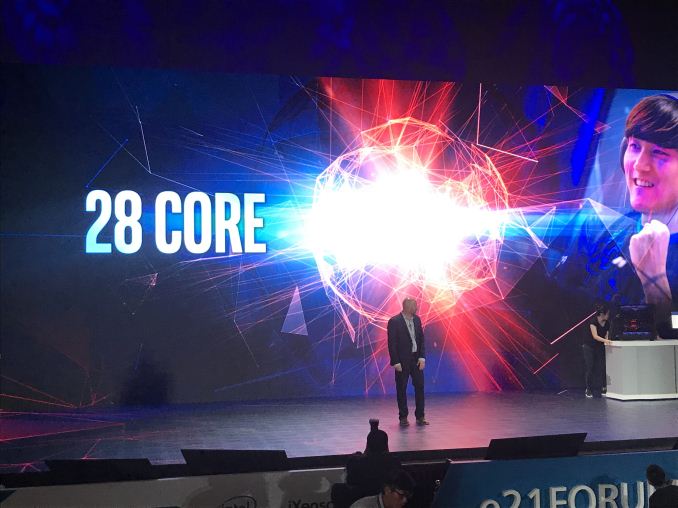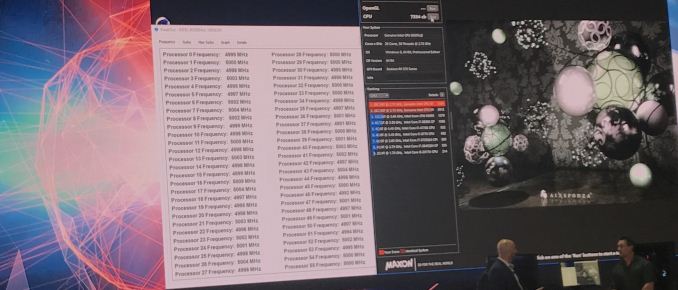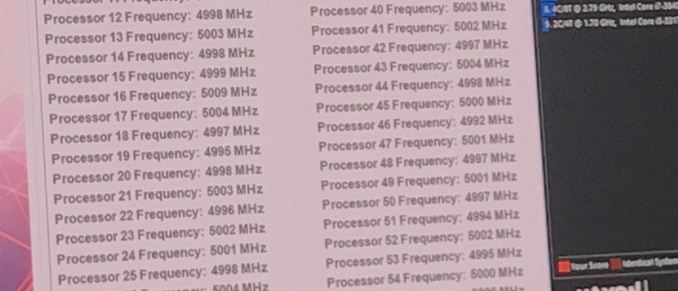Intel’s 28-Core 5 GHz CPU: Coming in Q4
by Ian Cutress on June 5, 2018 3:09 AM EST- Posted in
- CPUs
- Intel
- Trade Shows
- Computex 2018
- 28-core

Update 06/08: Intel has since backtracked on its initial statements, clarifying that while a 28-core part is coming in Q4 of this year, its stock frequency will not be 5GHz. Rather this was a (very poorly communicated) overclocking demo of the upcoming part. For more details, please see this article.
Alongside the launch of Intel’s first 5 GHz processor, the 6-core Core i7-8086K, Intel today also showcased a 28-core single socket machine also running at 5 GHz. The system on display scored 7334 in Cinebench R15, and Gregory Bryant (SVP and GM of Intel Client Computing Group) explicitly stated that it would be coming in Q4 this year.
No other details were provided, however for it to exist in a current platform, this new processor would likely be in LGA2066 (X299) or LGA3647 (the server socket). Intel technically already makes 28-core monolithic designs in the Intel Xeon Scalable Platform with the Xeon Platinum 8180, which is a $10k processor, which runs a lot slower than 5.0 GHz.
Personally, I feel this new processor is not a higher binned Platinum 8180. Going up from 2.8 GHz base / 3.5 GHz turbo to 5.0 GHz all-core frequency is a big step, assuming the 5.0 GHz value was not an overclock. I would fully expect that this is the point where Intel starts introducing EMIB to CPUs. (ed: FWIW, I disagree with Ian; my money is on a heavily binned 28-core XCC processor made on 14++. We've seen that Intel can do 5GHz on that process with the 8086K)
Last week I discussed the potential death of Intel’s low-end core design for high-end desktop, because it was being eclipsed by the mainstream parts. The only way Intel would be able to reuse the server versions of those low-core count designs would be to enable its embedded multi-die interconnect bridge (EMIB) technology to put two or more of the smaller dies on the same package. This would allow Intel do amortize costs in the same way AMD does by making use of higher yielding parts (as die size goes down, yield goes up).
Intel’s EMIB has a potentially high bi-directional bandwidth, so it would be interesting to see if Intel would bind two dies together and if there is any additional latency or bandwidth decrease with two dies together. With 28 cores, that would subdivide by two to 14-each, but not to four. So this processor is likely to be two 14-core dies using EMIB… which would actually be Intel’s HCC (high-core-count) processor design.
To add something extra to the mix, Intel might not be using EMIB at all. It could just as easily be the QPI interface on package, much how the company is using the Xeon + FPGA products announced recently.
So our primary questions to Intel would be:
- Monolithic or multi-die
- QPI or EMIB
- Socket
- Die size
- TDP / Power consumption at 5 GHz
TDP is a big part of the equation here. 28 cores at 5.0 GHz doesn’t come for free. The next questions are around price and launch date.
Additional:
There's the discussion about cutting into Intel's 1P market with such a product. But also, consider that at CES that Supermicro rated their X299 motherboards as supporting 300W processors, so it could easily correlate this processor to LGA2066 and a 300W TDP. That would be... fun... I guess?
| Want to keep up to date with all of our Computex 2018 Coverage? | ||||||
 Laptops |
 Hardware |
 Chips |
||||
| Follow AnandTech's breaking news here! | ||||||













87 Comments
View All Comments
Zizy - Tuesday, June 5, 2018 - link
I guess it will be heavily binned 8180 at 300W TDP if not even higher. In my opinion, 2066 makes slightly more sense. First, there is competitive reason: AMD's TR is a big shadow over 2066 stuff with 6C and 8C Intel desktop CPUs destroying value of LCC further - Intel might have to drop LCC and focus on HCC + XCC only to show some value in 2066 platform. What better way to start selling the stuff than with a halo part?Second, 2066 platform is more OC friendly and in domain of enthusiasts, which this chip seems to be aimed at.
Finally, limited to 1P suggests disabling of QPI, so disabling another 2 memory channels and some PCIe is a reasonable extra step to lower TDP further.
The Benjamins - Tuesday, June 5, 2018 - link
AMD just destroyed a 7890xe with the 24c TR 2000, and TR 2000 will have up to 32c. RIPeek2121 - Wednesday, June 6, 2018 - link
Not really, AMD's chips top out at 3.4 GHz. This is a 5 GHz 28 core part. It will be significantly faster than even AMD's 32 core part in pretty much all tasks, even benchmarks like Cinebench.Trefonix - Wednesday, June 6, 2018 - link
This is NOT a 5GHz core part. This is an extremely highly overclocked binned exotic cooling franken-chip. Considering the 18 core chips draws over 300w @ 4.6GHz and this is exactly the same architecture and process I'm willing to bet this draws in excess of 600w which is absolutely mad. Intel have made it seem like this is possible on every chip but in all likelihood this chip is running at over 1.5vChristopherFortineux - Friday, June 8, 2018 - link
Exactly, intel pulled a fast one on so many people with this stunt. Now, it will come back to haunt them. We are already hearing from sources that intel admitted this was an extremely unnecessarily over-clocked chip for the event.close - Sunday, June 10, 2018 - link
In this picture you can obviously see that the CPU is 2.7GHz:https://images.anandtech.com/doci/12893/image591.j...
But Ian still feels like mentioning "assuming the 5.0 GHz value was not an overclock". Amateur hour.
cyberguyz - Friday, June 8, 2018 - link
OMG where did you get the idea this chip when released will run anywhere near 5 Ghz? Take a look at the cooling used on that and the fact that the cooler uses a 1HP 230v motor to drive the chiller.No, you will be very disappointed not just in performance but the obscene cost of it when this is finally released.
ChristopherFortineux - Friday, June 8, 2018 - link
"AMD's chips top out at 3.4 GHz." Where are you getting this information from? MY 1950x runs 4.125Ghz on all cores on Air.Lolimaster - Thursday, June 7, 2018 - link
I can imagine the name for the 32core monstro.2950X++
ChristopherFortineux - Friday, June 8, 2018 - link
Just call it ThreadKiller9000